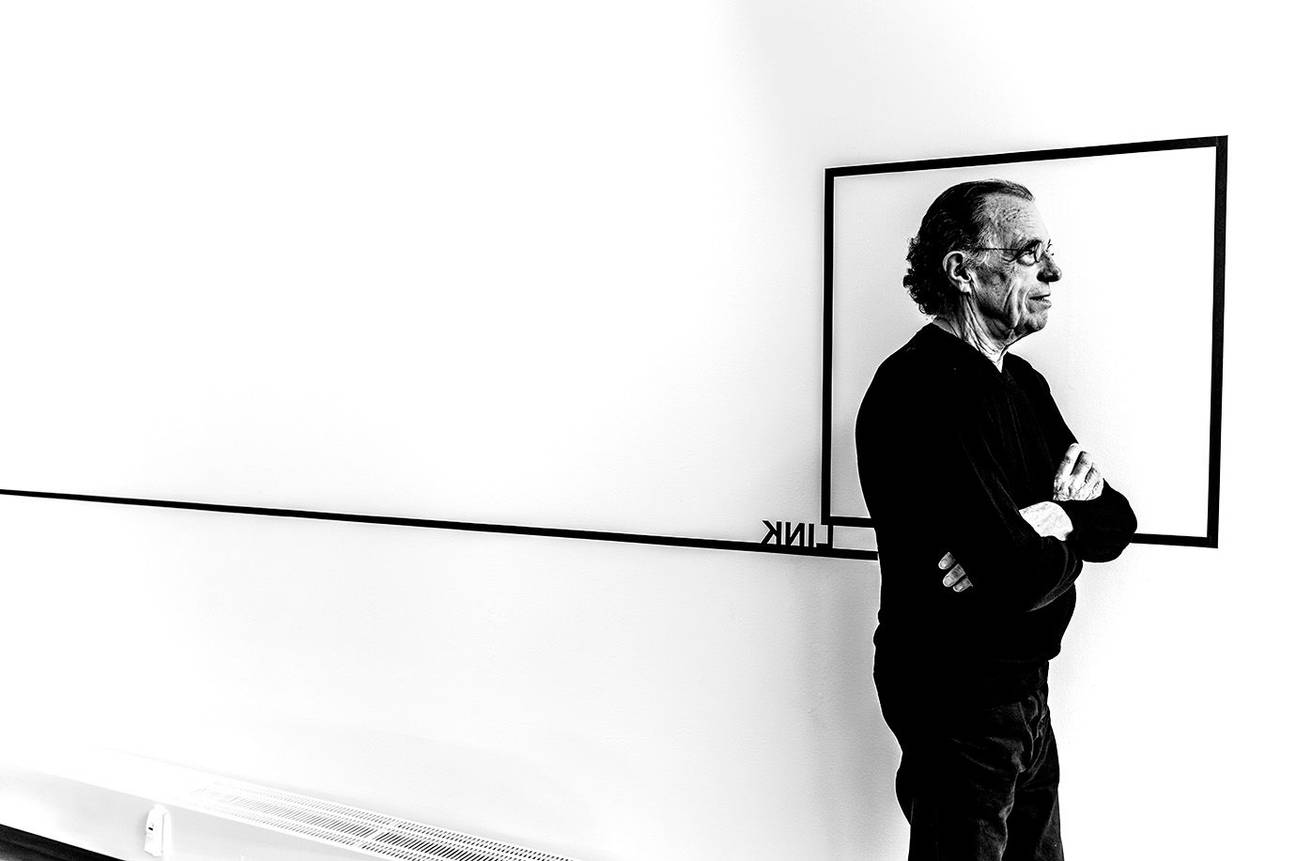With subtle gestures in space, the Brussels-based US artist Peter Downsbrough has been creating an extraordinary, multidisciplinary oeuvre that changes our ways of seeing and thinking. There’s poetry in motion at play in Été 78 and Relais 42.

© Saskia Vanderstichele
Brussels-based Peter Downsbrough creates poetry in motion
A whispered wake-up call, a gentle epiphany. This is the wonderful feeling that comes over you when you see Peter Downsbrough’s work. It is the realisation that you are looking at something that doesn’t only gently nudge the space you’re in, but in a fundamental sense, changes your ways of seeing and thinking. However subtle his accents are, the impact is enormous, as if they make you look at things for the first time again.
“Quite a lot of people have told me that this is the first time they realised that this space is a trapezoid, or that it has so many doors,” laughs Olivier Gevart, who along with his wife Nicole is the silent force behind Été 78, the arts space that is making a satellite connection with Relais 42 for Peter Downsbrough’s exhibition. Both spaces translate their passion for the arts into a generous approach that seeks to stimulate creation, exchange, and discovery through residencies and exhibitions.
“Whether they are public or private spaces, it is always different and it is always a challenge,” says New Jersey-born artist Peter Downsbrough (1940), who has been living in Brussels since 1989. “But this is the first time that I have made an exhibition spread across two independent spaces. It’s a nightmare.” [Laughs]
The “link” or “lien” – words put up in Été 78 and Relais 42, respectively – between the two spaces turns out to be as thrilling as his work in the public domain. “Interacting with the space with the least intrusion,” is how Peter Downsbrough describes his practice; a profound exploration and reflection on “space” through sculptures, videos, drawings, collages, photographs, and books.
“Because it isn’t about the object or the material. It’s about itself and its environment.” It is an act of reframing a space, by adding accents, cutting the space, or drawing lines through it. With minimal vocabulary, consisting of lines of black tape, aluminium pipes, poles, frames, or short, occasionally mirrored or cut words like “and”, “here”, “then”, “as”…
“The normal context of a word is a sentence. That is what defines words and makes clear what subtle meaning or implication is intended. By taking them out of their context, and only using one or two of them, you leave their meaning open-ended. So people have to put it into their own context; recontextualise it. ‘Link’ for example, can mean all kinds of things to all kinds of people. That way the work puts something into question and can start some kind of discussion.”
A slight turbulence
Peter Downsbrough’s interventions uncoil lines of thought, spark a dialogue. “More than changing the space, it is interacting with the space,” he says. “The space is a given. Somebody organised and designed it, and then I have the opportunity to put something into that space and enter into a dialogue with it, and ultimately with the people that use the space. People seeing or not seeing. Because when you walk along the street, you don’t see a large part of what is there. In 2003, I made a piece on boulevard Émile Jacqmainlaan, AND / MAAR, OP - AND / POUR, ET, but there are a lot of people who passed right by it without noticing it. I love that.”
Like the Two Pipes and Two Poles, dating back to the 1970s, which are “the idea of a sculpture redacted down to the question of two parallel vertical lines, a simple gesture, that doesn’t define, but demarks and delineates the space. Part of the force of those pieces was only noticeable when you took them down. Suddenly it wasn’t there anymore. It sat so well in the space, that taking it out, created a slight turbulence.”
At Été 78 and Relais 42, there are also a few of the books that Peter Downsbrough has published throughout the years, “volumes to walk through with your fingers, your eyes”, as well as a series of photographs of small commercial fisherman’s cabins on the coast in Kent or cityscapes like the Rijksadministratief Centrum/Cité administrative de l’État in Brussels.
“Photography is a large part of my practice. I started by photographing the Two Poles and Two Pipes pieces, but after a while, I went on to make photographs of the street, using a lamppost like a readymade vertical line, or creating diptychs and triptychs, where time is brought into play.”
Having worked for almost half a century, he has also witnessed many changes to the urban structure. “It doesn’t really affect my work. The basic language and vocabulary that are inherent in my work, can be overlaid on all kinds of different contexts. You adapt, you integrate into the changing environment. So the work grows, goes from A to B, from when it was made until it dies, when it falls apart or is taken down. If it goes three times the distance, that is fine too. It’s like the city with its constant growing pains. When you’re younger you think that things are just the way they are. And then you find out that it’s not like that. It’s growing, it’s organic, it just keeps changing in various ways.”
So you rethink, reframe, interact, and put poetry in motion.
> Peter Downsbrough. > 05/11 (by appointment) or 21/10, 28/10 & 04/11 (14.00 > 18.00), Été 78 & Relais 42, Elsene
Fijn dat je wil reageren. Wie reageert, gaat akkoord met onze huisregels. Hoe reageren via Disqus? Een woordje uitleg.